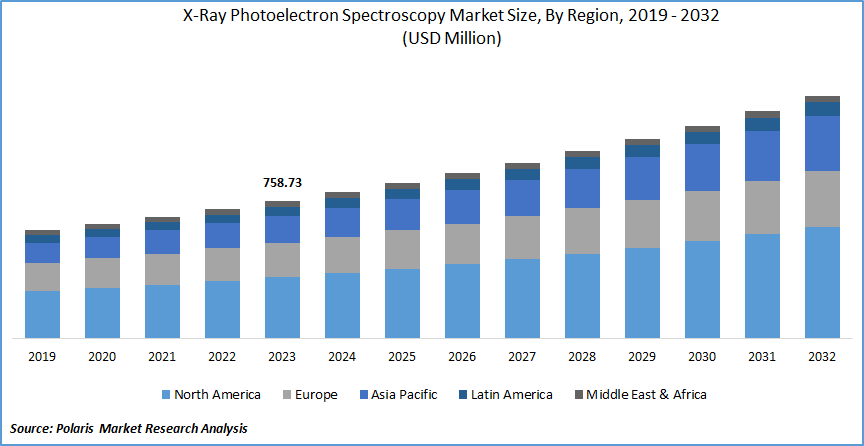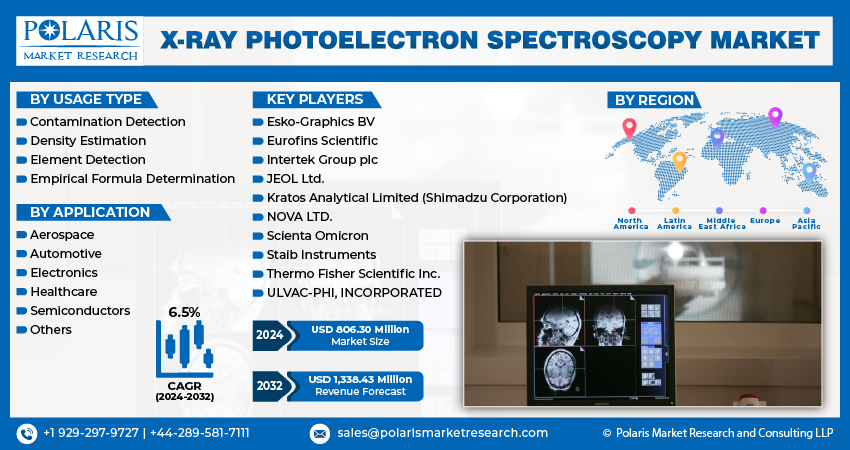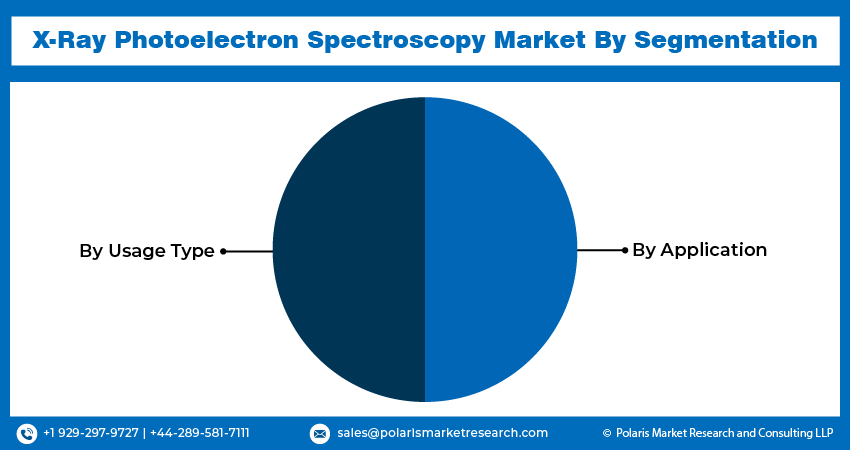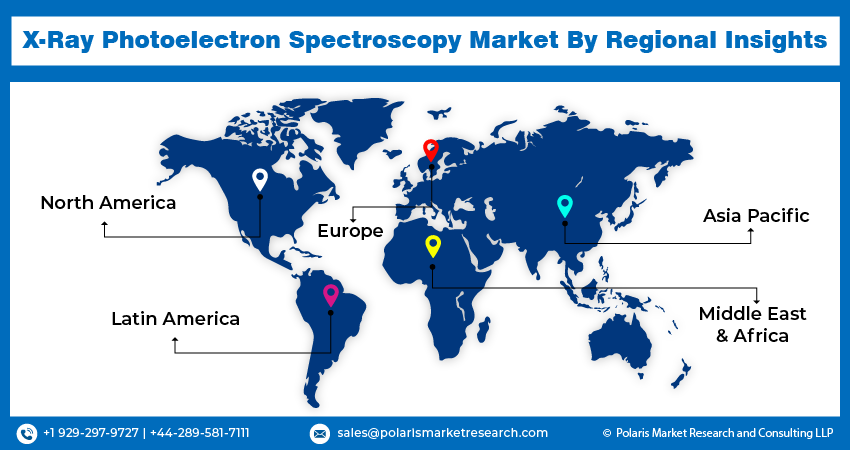
X-Ray Photoelectron Spectroscopy Market Share, Size, Trends, Industry Usage Report, By Usage Type (Contamination Detection, Element Detection, Density Estimation, Empirical Formula Determination); By Application; By Region; Segment Forecast, 2024 - 2032
- Published Date:Jun-2024
- Pages: 117
- Format: PDF
- Report ID: PM1310
- Base Year: 2023
- Historical Data: 2019-2022
Report Outlook
X-ray photoelectron spectroscopy market size was valued at USD 758.73 million in 2023. The market is anticipated to grow from USD 806.30 million in 2024 to USD 1,338.43 million by 2032, exhibiting the CAGR of 6.5% during the forecast period.
Industry Trends
X-ray photoelectron spectroscopy (XPS) is a powerful analytical technique used to study the surface chemistry of materials. It works by irradiating a material with X-rays, which causes the emission of photoelectrons from the material's surface. By measuring the kinetic energy and the number of electrons that escape, XPS provides detailed information about the elemental composition, chemical state, and electronic state of the elements within the top few nanometers of the material's surface.

To Understand More About this Research:Request a Free Sample Report
The X-ray Photoelectron Spectroscopy (XPS) market is experiencing significant growth, driven by advancements in materials science and the increasing demand for precise surface usage across various industries. Key sectors such as electronics, aerospace, automotive, and pharmaceuticals are adopting XPS for its ability to provide detailed surface composition and chemical state information, which is crucial for developing advanced materials and ensuring product quality. The growing emphasis on nanotechnology and the development of novel materials, including thin films and coatings, further propel the demand for XPS, as these applications require meticulous surface characterization.
Market trends in the XPS industry are marked by a growing preference for high-throughput and automated systems, which offer enhanced efficiency and accuracy in analytical processes. There is also a noticeable shift towards integrating XPS with other analytical techniques, such as Auger Electron Spectroscopy (AES) and Time-of-Flight Secondary Ion Mass Spectrometry (ToF-SIMS), to provide comprehensive surface usage solutions. Technological innovations, such as the development of improved detectors and software for data usage, are revolutionizing the capabilities of XPS instruments.
For instance, in July 2022, ULVAC-PHI Incorporated, based in Japan, has introduced the PHI GENESIS, an advanced scanning X-ray photoelectron spectrometer with automated multi-function capabilities. The PHI GENESIS represents a comprehensive model integrating PHI's diverse range of functionalities.
These advancements are making XPS systems more user-friendly and capable of handling complex analytical tasks, thereby driving the growth of the market. However, the XPS market is hindered by the high cost of XPS instruments. The complexity of their operation and maintenance are significant barriers for smaller research laboratories and institutions.
Key Takeaways
- North America dominated the market and contributed over 35% market share of the X-ray photoelectron spectroscopy market in 2023
- By usage type category, the element detection segment dominated the global X-ray photoelectron spectroscopy market size in 2023
- By application category, the healthcare segment is projected to grow with a significant CAGR over the X-ray photoelectron spectroscopy market forecast period
What are the Market Drivers Driving the Demand for Market?
Increasing Research and Development in Materials Science
As scientists and engineers strive to develop new materials with advanced properties for applications in electronics, energy storage, aerospace, and other high-tech industries, they require sophisticated tools to analyze these materials at the atomic and molecular levels. XPS provides crucial insights into the surface composition, chemical states, and electronic states of materials, which are essential for understanding and optimizing their performance. For instance, in the development of thin films, nanomaterials, and complex coatings, precise surface characterization is vital to ensure material reliability and functionality. Thus, the increasing R&D efforts in materials science fuel the demand for XPS technology, as it enables researchers to achieve the detailed and accurate surface analysis necessary for innovation and quality control in innovative material development.
Which Factor is Restraining the Demand for the Market?
Complexity in Operating and Maintaining XPS Systems
Operating and maintaining these sophisticated instruments requires a high level of technical expertise to operate effectively, including a deep understanding of both the theoretical principles and practical aspects of XPS. Setting up experiments, calibrating the equipment, and interpreting the complex data generated by XPS all demand specialized skills that are not easily available. In addition, maintaining these systems involves regular calibration, troubleshooting, and sometimes costly repairs or part replacements, which is expensive for institutions without dedicated technical support teams. This operational complexity deters smaller research laboratories and organizations with limited resources from adopting XPS technology, thereby limiting its broader market penetration despite its strong analytical capabilities.

Report Segmentation
The market is primarily segmented based on usage type, application, and region.
|
By Usage Type |
By Application |
By Region |
|
|
|
To Understand the Scope of this Report:Speak to Analyst
Category Wise Insights
By Usage Type Insights
Based on usage type category usage, the market has been segmented on the basis of contamination detection, element detection, density estimation, and empirical formula determination. The element detection segment dominated the global market in 2023 due to its critical role in a wide range of scientific and industrial applications. XPS is highly valued for its ability to precisely identify and quantify the elemental composition of material surfaces, which is essential for quality control, failure analysis, and the development of advanced materials.
Industries such as electronics, aerospace, automotive, and pharmaceuticals heavily rely on accurate element detection to ensure the performance and reliability of their products. For instance, in semiconductor manufacturing, detecting trace elements on surfaces is crucial for preventing defects and enhancing device performance. In addition, the ongoing advancements in nanotechnology and the increasing focus on developing new materials have further amplified the demand for robust element detection capabilities, solidifying the dominance of this segment in the XPS market.
By Application Insights
Based on application category usage, the market has been segmented on the basis of aerospace, automotive, electronics, healthcare, semiconductors, and others. The healthcare application segment is projected to grow with a significant CAGR over the forecast period in the market due to the increasing demand for advanced surface characterization techniques in biomedical research and medical device development. XPS is instrumental in analyzing the surface chemistry of biomaterials, drug delivery systems, and medical implants, ensuring they interact optimally with biological environments. As the healthcare industry advances towards personalized medicine and innovative treatments, the need for precise surface analysis to understand and control biointerfaces becomes more critical.
The rising focus on developing new biomaterials and coatings to improve the performance and longevity of implants and prosthetics also contributes to the robust growth of the healthcare application segment in the XPS market.

Regional Insights
North America
In 2023, North America emerged as the dominant region in the global XPS market due to a combination of robust research infrastructure, significant investment in advanced technologies, and a strong presence of key industry players. The region's leading universities and research institutions are heavily involved in materials science and nanotechnology research, driving the demand for sophisticated analytical tools like XPS. Also, North America is home to numerous high-tech industries, including electronics, aerospace, and pharmaceuticals, which rely on XPS for quality control and material characterization. Substantial government funding for scientific research and development, coupled with active collaboration between academic and industrial sectors, further supports the growth of the XPS market in the region.
Asia Pacific
The Asia Pacific region is anticipated to grow substantially in the market due to rapid industrialization, increasing investment in research and development, and the expanding high-tech manufacturing sector. Countries like China, Japan, South Korea, and India are investing heavily in advancing their scientific infrastructure and capabilities, particularly in fields such as materials science, nanotechnology, and electronics. The region's burgeoning electronics and semiconductor industries, which require precise surface analysis for quality control and innovation, are significant drivers of XPS adoption.

Competitive Landscape
The competitive landscape for the XPS market is characterized by the presence of several key players who are driving innovation and technological advancements in the field. Leading companies dominate the market with their advanced XPS systems and extensive global distribution networks. These companies continuously invest in research and development to enhance the capabilities, accuracy, and user-friendliness of their XPS instruments. The market also sees competition from emerging players who are introducing cost-effective and specialized XPS solutions tailored to specific industry needs.
Some of the major players operating in the global market include:
- Esko-Graphics BV
- Eurofins Scientific
- Intertek Group plc
- JEOL Ltd.
- Kratos Analytical Limited (Shimadzu Corporation)
- NOVA LTD.
- Scienta Omicron
- Staib Instruments
- Thermo Fisher Scientific Inc.
- ULVAC-PHI, INCORPORATED
Recent Developments
- In May 2021, Thermo Fisher Scientific has introduced the Thermo Scientific Nexsa G2 surface analysis system. This fully automated X-ray photoelectron spectrometer (XPS) is specifically designed to enhance productivity and drive innovation in academic and industrial laboratories.
Report Coverage
The X-ray photoelectron spectroscopy market report emphasizes on key regions across the globe to provide better understanding of the product to the users. Also, the report provides market insights into recent developments, trends and analyzes the technologies that are gaining traction around the globe. Furthermore, the report covers in-depth qualitative usage pertaining to various paradigm shifts associated with the transformation of these solutions.
The report provides detailed usage of the market while focusing on various key aspects such as competitive usage, usage type, application, and their futuristic growth opportunities.
X-Ray Photoelectron Spectroscopy Market Report Scope
|
Report Attributes |
Details |
|
Market size value in 2024 |
USD 806.30 million |
|
Revenue forecast in 2032 |
USD 1,338.43 million |
|
CAGR |
6.5% from 2024 – 2032 |
|
Base year |
2023 |
|
Historical data |
2019 – 2022 |
|
Forecast period |
2024 – 2032 |
|
Quantitative units |
Revenue in USD million and CAGR from 2024 to 2032 |
|
Segments covered |
By Usage Type, By Application, By Region |
|
Regional scope |
North America, Europe, Asia Pacific, Latin America, Middle East & Africa |
|
Customization |
Report customization as per your requirements with respect to countries, region, and segmentation. |
FAQ's
The key companies in X-Ray Photoelectron Spectroscopy Market are Esko-Graphics BV, Eurofins Scientific, Intertek Group plc, JEOL Ltd
X-ray photoelectron spectroscopy market exhibiting the CAGR of 6.5% during the forecast period
X-Ray Photoelectron Spectroscopy Market report covering key segments are usage type, application, and region
The key driving factors in X-Ray Photoelectron Spectroscopy Market are High demand from industries such as electronics, aerospace, automotive, and healthcare
X-Ray Photoelectron Spectroscopy Market Size Worth USD 1,338.43 Million by 2032
